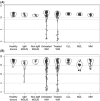Clonal architecture of CXCR4 WHIM-like mutations in Waldenström Macroglobulinaemia
- PMID: 26659815
- PMCID: PMC5409813
- DOI: 10.1111/bjh.13897
Clonal architecture of CXCR4 WHIM-like mutations in Waldenström Macroglobulinaemia
Abstract
CXCR4(WHIM) somatic mutations are distinctive to Waldenström Macroglobulinaemia (WM), and impact disease presentation and treatment outcome. The clonal architecture of CXCR4(WHIM) mutations remains to be delineated. We developed highly sensitive allele-specific polymerase chain reaction (AS-PCR) assays for detecting the most common CXCR4(WHIM) mutations (CXCR4(S338X C>A and C>G) ) in WM. The AS-PCR assays detected CXCR4(S338X) mutations in WM and IgM monoclonal gammopathy of unknown significance (MGUS) patients not revealed by Sanger sequencing. By combined AS-PCR and Sanger sequencing, CXCR4(WHIM) mutations were identified in 44/102 (43%), 21/62 (34%), 2/12 (17%) and 1/20 (5%) untreated WM, previously treated WM, IgM MGUS and marginal zone lymphoma patients, respectively, but no chronic lymphocytic leukaemia, multiple myeloma, non-IgM MGUS patients or healthy donors. Cancer cell fraction analysis in WM and IgM MGUS patients showed CXCR4(S338X) mutations were primarily subclonal, with highly variable clonal distribution (median 35·1%, range 1·2-97·5%). Combined AS-PCR and Sanger sequencing revealed multiple CXCR4(WHIM) mutations in many individual WM patients, including homozygous and compound heterozygous mutations validated by deep RNA sequencing. The findings show that CXCR4(WHIM) mutations are more common in WM than previously revealed, and are primarily subclonal, supporting their acquisition after MYD88(L265P) in WM oncogenesis. The presence of multiple CXCR4(WHIM) mutations within individual WM patients may be indicative of targeted CXCR4 genomic instability.
Keywords: CXCR4; IgM MGUS; MYD88 L265P; Marginal Zone Lymphoma; WHIM; Waldenström macroglobulinaemia.
© 2015 John Wiley & Sons Ltd.
Conflict of interest statement
Figures





References
-
- Arcaini L, Varettoni M, Boveri E, Orlandi E, Rattotti S, Zibellini S, Merli M, Lucioni M, Rizzi S, Gotti M, Morello L, Pascutto C, Paulli M. Distinctive clinical and histological features of Waldenstrom's Macroglobulinemia and splenic marginal zone lymphoma. Clinical Lymphoma Myeloma Leukemia. 2011;11:103–105. - PubMed
-
- Cao Y, Hunter ZR, Liu X, Xu L, Yang G, Chen J, Patterson CJ, Tsakmaklis N, Kanan S, Rodig S, Castillo JJ, Treon SP. The WHIM-like CXCR4S338X somatic mutation activates AKT and ERK, and promotes resistance to ibrutinib and other agents used in the treatment of Waldenstrom's Macroglobulinemia. Leukemia. 2015;29:169–176. - PubMed
-
- Dotta L, Tassone L, Badolato R. Clinical and genetic features of Warts, Hypogammaglobulinemia, Infections and Myelokathexis (WHIM) syndrome. Current Molecular Medicine. 2011;11:317–325. - PubMed
-
- Hunter ZR, Xu L, Yang G, Zhou Y, Liu X, Cao Y, Manning RJ, Tripsas C, Patterson CJ, Sheehy P, Treon SP. The genomic landscape of Waldenstöm's Macroglobulinemia is characterized by highly recurring MYD88 and WHIM-like CXCR4 mutations, and small somatic deletions associated with B-cell lymphomagenesis. Blood. 2014;123:1637–1646. - PubMed
-
- Jiménez C, Sebastián E, Chillón MC, Giraldo P, Mariano Hernández J, Escalante F, González-López TJ, Aguilera C, de Coca AG, Murillo I, Alcoceba M, Balanzategui A, Sarasquete ME, Corral R, Marín LA, Paiva B, Ocio EM, Gutiérrez NC, González M, San Miguel JF, García-Sanz R. MYD88 L265P is a marker highly characteristic of, but not restricted to Waldenström's macroglobulinemia. Leukemia. 2013;27:1722–1728. - PubMed
Publication types
MeSH terms
Substances
Grants and funding
LinkOut - more resources
Full Text Sources
Other Literature Sources
Research Materials

